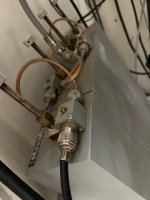I have two duplexers that are in mint condition (physically) but I do not know the past history. I inherited them from an agency who did away with VHF high band. They honestly look like they have never been used but no guarantees.
The first is a Sinclair Q2220E and the second is a Q202.
The Q2220E gives slightly over 75 dB of rejection at the notches and has around 1.4 dB of insertion loss. The Q202 has slightly better specs, around 85 dB of rejection with the same insertion loss as the previous, only with somewhat better selectivity. Return loss and VSWR through all ports are better than spec on both. All specs exceed the datasheets.
Each duplexer will tune smoothly. Pass plungers are tight, but not too tight. Just the perfect amount of physical resistance you would expect. Likewise, all notch trimmer capacitors are smooth in tuning and just enough tension for the right "feel." All brass caps were in place on the capacitors and the units are clean.
I started with the first, the Q2220E, with frequencies of 147.00 and 147.60 MHz. Repeater worked great at 75W output with no desense to the RX. Several days later, I noticed receive signals were down. I checked, and desense was in excess of 10 dB. I checked the duplexer, and both the high and low pass notches were WAY off. I re-tuned, and all was well. Days later, the same happens. This goes on for several days and each time I check, the notches are slightly off frequency. The duplexer pass is fine, but the notches won't stay stable.
I then tried the Q202, which uses the same identical coupling loops, and I get the exact same thing. They will NOT stay stable.
I pulled all the coupling loops out, and examined each capacitor. They seem to be Johansen 1-30 pF caps. They are very clean, no burn marks, no cracks in the ceramic. I have physically examined all parts of the cavity and find nothing wrong. I can't imagine ALL of the capacitors are bad. I put all the cores back in and retuned, and the same thing happens. This has been going on for several weeks.
I am using an Anritsu S820 for a tracking gen/VNA. The building is climate-controlled at a constant 72 degrees and no, the AC vent is not blowing directly on the cavities. The VSWR on my antenna is around 1.3:1 at the duplexer input.
Any thoughts?
The first is a Sinclair Q2220E and the second is a Q202.
The Q2220E gives slightly over 75 dB of rejection at the notches and has around 1.4 dB of insertion loss. The Q202 has slightly better specs, around 85 dB of rejection with the same insertion loss as the previous, only with somewhat better selectivity. Return loss and VSWR through all ports are better than spec on both. All specs exceed the datasheets.
Each duplexer will tune smoothly. Pass plungers are tight, but not too tight. Just the perfect amount of physical resistance you would expect. Likewise, all notch trimmer capacitors are smooth in tuning and just enough tension for the right "feel." All brass caps were in place on the capacitors and the units are clean.
I started with the first, the Q2220E, with frequencies of 147.00 and 147.60 MHz. Repeater worked great at 75W output with no desense to the RX. Several days later, I noticed receive signals were down. I checked, and desense was in excess of 10 dB. I checked the duplexer, and both the high and low pass notches were WAY off. I re-tuned, and all was well. Days later, the same happens. This goes on for several days and each time I check, the notches are slightly off frequency. The duplexer pass is fine, but the notches won't stay stable.
I then tried the Q202, which uses the same identical coupling loops, and I get the exact same thing. They will NOT stay stable.
I pulled all the coupling loops out, and examined each capacitor. They seem to be Johansen 1-30 pF caps. They are very clean, no burn marks, no cracks in the ceramic. I have physically examined all parts of the cavity and find nothing wrong. I can't imagine ALL of the capacitors are bad. I put all the cores back in and retuned, and the same thing happens. This has been going on for several weeks.
I am using an Anritsu S820 for a tracking gen/VNA. The building is climate-controlled at a constant 72 degrees and no, the AC vent is not blowing directly on the cavities. The VSWR on my antenna is around 1.3:1 at the duplexer input.
Any thoughts?


